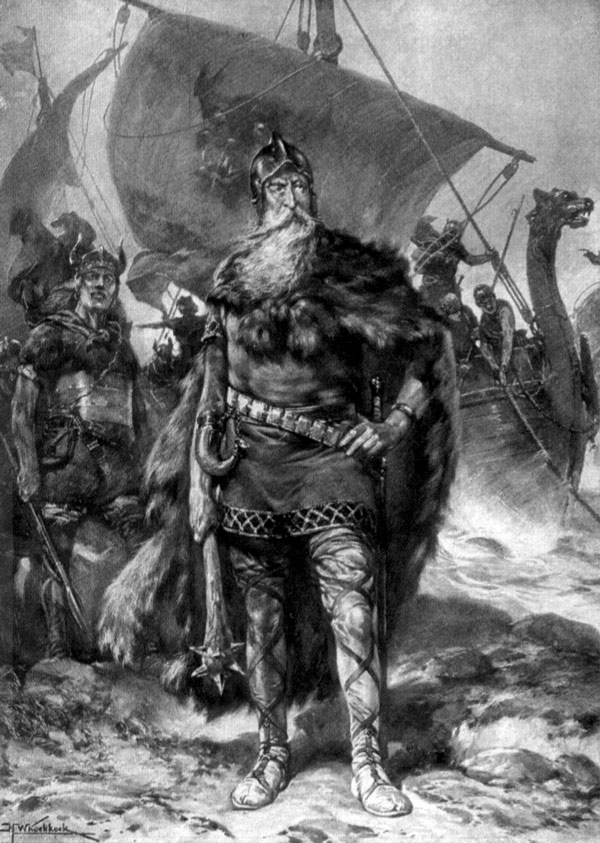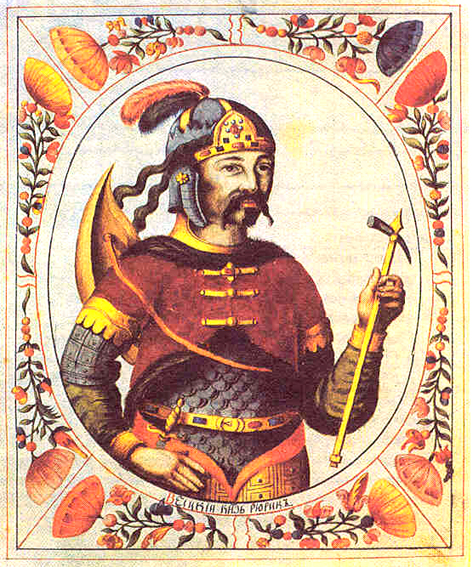|
Shum Gora
200px, Shum-gora, August 2013, as viewed from the North-East Shum Gora (russian: Шум-гора: "Noise Hill") is a massive kurgan (tumulus) situated in Peredolskaya Volost, near the bank of the Luga River, Batetsky District, Novgorod Oblast, northwestern Russia, about 60 km west of Novgorod. The hill was formerly involved in local liturgical practice. 19th century sources record that three crosses standing on its top, but by the 20th century these had been removed. During the mid 19th century, there used to be processions, with pilgrims walking three times around the hill before ascending it to "listen to the noise" and leave small sacrifices in a pit at the top. People suffering from headache used to put sand from the pit in their ears. These practices are described by A. A. Panchenko in 1998. The site and the associated folk customs were first described by M. Bystrov in 1879. Bystrov records the tradition that the sand from the hill had miraculous power on Trinity Sunday ... [...More Info...] [...Related Items...] OR: [Wikipedia] [Google] [Baidu] |
Georadar
Ground-penetrating radar (GPR) is a geophysical method that uses radar pulses to image the subsurface. It is a non-intrusive method of surveying the sub-surface to investigate underground utilities such as concrete, asphalt, metals, pipes, cables or masonry. This nondestructive method uses electromagnetic radiation in the microwave band (UHF/VHF frequencies) of the radio spectrum, and detects the reflected signals from subsurface structures. GPR can have applications in a variety of media, including rock, soil, ice, fresh water, pavements and structures. In the right conditions, practitioners can use GPR to detect subsurface objects, changes in material properties, and voids and cracks. GPR uses high-frequency (usually polarized) radio waves, usually in the range 10 MHz to 2.6 GHz. A GPR transmitter and antenna emits electromagnetic energy into the ground. When the energy encounters a buried object or a boundary between materials having different permittivities, it may ... [...More Info...] [...Related Items...] OR: [Wikipedia] [Google] [Baidu] |
Kurgans
A kurgan is a type of tumulus constructed over a grave, often characterized by containing a single human body along with grave vessels, weapons and horses. Originally in use on the Pontic–Caspian steppe, kurgans spread into much of Central Asia and Eastern, Southeast, Western and Northern Europe during the 3rd millennium BC. The earliest kurgans date to the 4th millennium BC in the Caucasus, and a part of researchers associate these with the Indo-Europeans. Kurgans were built in the Eneolithic, Bronze, Iron, Antiquity and Middle Ages, with ancient traditions still active in Southern Siberia and Central Asia. Etymology According to the Etymological dictionary of the Ukrainian language the word "kurhan" is borrowed directly from the "Polovtsian" language ( Kipchak, part of the Turkic languages) and means: fortress, embankment, high grave. The word has two possible etymologies, either from the Old Turkic root ''qori-'' "to close, to block, to guard, to protect", or ''qur-'' ... [...More Info...] [...Related Items...] OR: [Wikipedia] [Google] [Baidu] |
Archaeological Sites In Russia
Archaeology or archeology is the scientific study of human activity through the recovery and analysis of material culture. The archaeological record consists of Artifact (archaeology), artifacts, architecture, biofact (archaeology), biofacts or ecofacts, archaeological site, sites, and cultural landscapes. Archaeology can be considered both a social science and a branch of the humanities. It is usually considered an independent academic discipline, but may also be classified as part of anthropology (in North America – the four-field approach), history or geography. Archaeologists study human prehistory and history, from the development of the first stone tools at Lomekwi in East Africa 3.3 million years ago up until recent decades. Archaeology is distinct from palaeontology, which is the study of fossil remains. Archaeology is particularly important for learning about prehistoric societies, for which, by definition, there are no written records. Prehistory includes ove ... [...More Info...] [...Related Items...] OR: [Wikipedia] [Google] [Baidu] |
Rorik Of Dorestad
Rorik (''Roricus, Rorichus''; Old Norse ''HrœrekR'', c. 810 – c. 880) was a Danish Viking, who ruled over parts of Friesland between 841 and 873, conquering Dorestad and Utrecht in 850. Rorik swore allegiance to Louis the German in 873. He was born in Denmark around 800. He died at some point between 873 and 882. Since the 19th century, there have been attempts to identify him with Rurik, the founder of the Rurikid dynasty. Family He had a brother named Harald. Harald Klak was probably their uncle, and Godfrid Haraldsson their cousin.Luit van der Tuuk, "The Danish role in the decay of Dorestad" The identity of his father remains uncertain. There are various interpretations of the primary sources on his family, particularly because names such as Harald are re ... [...More Info...] [...Related Items...] OR: [Wikipedia] [Google] [Baidu] |
Kievan Rus
Kievan Rusʹ, also known as Kyivan Rusʹ ( orv, , Rusĭ, or , , ; Old Norse: ''Garðaríki''), was a state in Eastern and Northern Europe from the late 9th to the mid-13th century.John Channon & Robert Hudson, ''Penguin Historical Atlas of Russia'' (Penguin, 1995), p.14–16.Kievan Rus Encyclopædia Britannica Online. Encompassing a variety of polities and peoples, including East Slavic, , and Finnic, it was ruled by the |
Rurik
Rurik (also Ryurik; orv, Рюрикъ, Rjurikŭ, from Old Norse ''Hrøríkʀ''; russian: Рюрик; died 879); be, Рурык, Ruryk was a semi-legendary Varangian chieftain of the Rus' who in the year 862 was invited to reign in Novgorod. According to the ''Primary Chronicle'', Rurik was succeeded by his kinsman Oleg who was regent for his infant son Igor. He is considered to be the founder of the Rurik dynasty, which went on to rule Kievan Rus' and its principalities, and then the Tsardom of Russia, until the death of Feodor I in 1598. Vasili IV, who reigned until 1610, was the last Rurikid monarch of Russia. Life The only surviving information about Rurik is contained in the 12th-century ''Primary Chronicle'' written by one Nestor, which states that Chuds, Eastern Slavs, Merias, Veses, and Krivichs "drove the Varangians back beyond the sea, refused to pay them tribute, and set out to govern themselves". Afterwards the tribes started fighting each other and ... [...More Info...] [...Related Items...] OR: [Wikipedia] [Google] [Baidu] |
Raknehaugen
Rakni's Mound ( no, Raknehaugen) is a large mound at Ullensaker in Akershus county, Norway. It is the largest free-standing prehistoric monument in Norway and is one of the largest barrows in Northern Europe. It dates to the Migration Age and has been the subject of three archaeological investigations. Description and location The mound is 77 metres in diameter and over 15 metres in height,Rakni's Mound—The Largest Barrow in Northern Europe , Rakni's Mound, Akershus Kulturnett. the largest in Scandinavia.Frans-Arne Stylegar "Raknehaugen" '' |
Russian Academy Of Sciences
The Russian Academy of Sciences (RAS; russian: Росси́йская акаде́мия нау́к (РАН) ''Rossíyskaya akadémiya naúk'') consists of the national academy of Russia; a network of scientific research institutes from across the Russian Federation; and additional scientific and social units such as libraries, publishing units, and hospitals. Peter the Great established the Academy (then the St. Petersburg Academy of Sciences) in 1724 with guidance from Gottfried Leibniz. From its establishment, the Academy benefitted from a slate of foreign scholars as professors; the Academy then gained its first clear set of goals from the 1747 Charter. The Academy functioned as a university and research center throughout the mid-18th century until the university was dissolved, leaving research as the main pillar of the institution. The rest of the 18th century continuing on through the 19th century consisted of many published academic works from Academy scholars and a few Ac ... [...More Info...] [...Related Items...] OR: [Wikipedia] [Google] [Baidu] |
Flag Of Batetsky Rayon (Novgorod Oblast)
A flag is a piece of fabric (most often rectangular or quadrilateral) with a distinctive design and colours. It is used as a symbol, a signalling device, or for decoration. The term ''flag'' is also used to refer to the graphic design employed, and flags have evolved into a general tool for rudimentary signalling and identification, especially in environments where communication is challenging (such as the maritime environment, where semaphore is used). Many flags fall into groups of similar designs called flag families. The study of flags is known as "vexillology" from the Latin , meaning "flag" or "banner". National flags are patriotic symbols with widely varied interpretations that often include strong military associations because of their original and ongoing use for that purpose. Flags are also used in messaging, advertising, or for decorative purposes. Some military units are called "flags" after their use of flags. A ''flag'' (Arabic: ) is equivalent to a brigade ... [...More Info...] [...Related Items...] OR: [Wikipedia] [Google] [Baidu] |
Kurgan
A kurgan is a type of tumulus constructed over a grave, often characterized by containing a single human body along with grave vessels, weapons and horses. Originally in use on the Pontic–Caspian steppe, kurgans spread into much of Central Asia and Eastern, Southeast, Western and Northern Europe during the 3rd millennium BC. The earliest kurgans date to the 4th millennium BC in the Caucasus, and a part of researchers associate these with the Indo-Europeans. Kurgans were built in the Eneolithic, Bronze, Iron, Antiquity and Middle Ages, with ancient traditions still active in Southern Siberia and Central Asia. Etymology According to the Etymological dictionary of the Ukrainian language the word "kurhan" is borrowed directly from the "Polovtsian" language ( Kipchak, part of the Turkic languages) and means: fortress, embankment, high grave. The word has two possible etymologies, either from the Old Turkic root ''qori-'' "to close, to block, to guard, to protect", or ''qur ... [...More Info...] [...Related Items...] OR: [Wikipedia] [Google] [Baidu] |
Trinity Sunday
Trinity Sunday is the first Sunday after Pentecost in the Western Christian liturgical calendar, and the Sunday of Pentecost in Eastern Christianity. Trinity Sunday celebrates the Christian doctrine of the Trinity, the three Persons of God: the Father, the Son, and the Holy Spirit. Western Christianity Trinity Sunday is celebrated in all the Western liturgical churches: Latin Catholic, Anglican, Lutheran, Presbyterian, United Church of Christ, and Methodist. History In the early Church, no special Office or day was assigned for the Holy Trinity. When the Arian heresy was spreading, the Fathers prepared an Office with canticles, responses, a Preface, and hymns, to be recited on Sundays. In the Sacramentary of St. Gregory the Great there are prayers and the Preface of the Trinity. During the Middle Ages, especially during the Carolingian period, devotion to the Blessed Trinity was a highly important feature of private devotion and inspired several liturgical expressions. Sunday ... [...More Info...] [...Related Items...] OR: [Wikipedia] [Google] [Baidu] |
.png)


.jpg)





